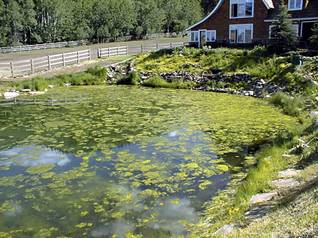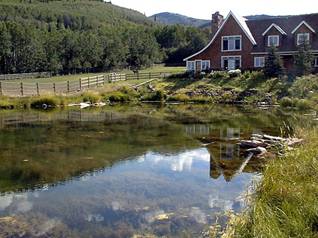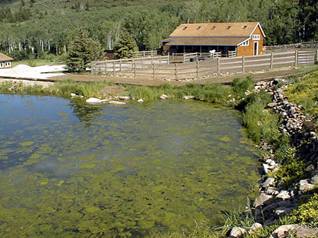The Problem
There is a clear need for a safe, effective means to reduce or eliminate organic waste build-up, toxic ammonia concentrations, and algae blooms. A solution which works in both commercial aquaculture, aquariums, decorative fountains and pond situations.
In addition, although a variety of water filtration systems are currently available, all biological systems, regardless of the particular design, require frequent maintenance and upgrading in order for them to work efficiently. An inefficient filtration system is a serious problem for all aquaculture situations since the filtration system can actually increase the amount of available nutrient and organic matter in the system, thereby compounding an already serious problem.
The Solution
BD-C has been specially designed to inhibit algae growth by removing its food sources. Biodigesters (affectionately referred to as “bugs”) are a combination of all natural bacteria, lab grade purified enzymes with micro and macronutrients. BD-C bacteria and enzymes are targeted to the food sources available in pond water. Our Bugs can successfully attack, degrade, and liquefy fecal mass, undigested food, and other organics that contribute to a build-up of ammonia and bottom solids. By adding Biodigesters you bring condition the marine environment ecology, closest to natures own.
Biodigesters will colonize the tank/pond, multiply by a factor up to 1,000 times within a few hours, take away the nutrients that encourage algae (thus eliminating unsightly growth on walls and surfaces), and liberate carbon dioxide for oxygenating plants.
Biodigester microbes are reliable scavengers that thrive on organic mass (waste). As supplied they are in suspended animation (micro-encapsulated) but are revived when added to the tank / pond water. Shortly thereafter, they begin to digest excreta, excess food, oxidize ammonia, reduce nitrites, nitrates, and other N-Compounds while reducing odors.
How Biodigesters Work
Aquatic ponds and tanks frequently become plagued with; algae in many forms, fish excrement, ammonia, nitrates and nitrites and poor water clarity from organic matter. By out competing the natural occurring bacteria for the available food sources, algae and odor causing bacteria die off and thus the objectionable smell is eliminated. In addition it consumes pond waste; bottom solids, fish excrement, organic and plant matter while eliminating odors.
Biodigesters proprietary blend of all natural bio-cultures and enzymes have been selected for their ability to effectively digest/degrade extremely heavy concentrations of organic mass within an aquatic system. Reducing those hostile factors that have been determined to be detrimental to the health and life cycle of both fin and shell fish.




Why Biodigesters vs Others
Some products utilize bacterial strains such as nitric-ammonias and nitrobacterium found naturally in pond water. These bacterial species break down ammonia into nitrate and then into nitrite, it then leaves the water in the form of a gas. These strains are not particularly effective in ponds due to their pH sensitive nature. A pH of less than 6.7 or more than 7.4 will kill them. They are highly ineffective against algae.
BD-C Takes Another Pathway
BD-C targets phosphorus and nitrogen that promote algae growth while utilizing ammonia, nitrates and nitrites as additional food sources. Our de-nitrification process is much faster and more effective. Rather than step breakdown from ammonia into nitrate and then into nitrite, all are consumed simultaneously by BD-C. This promotes an overall reduction of ammonia compounds.
Biodigesters vs Chemicals
Although a variety of chemicals are currently available to reduce algae blooms, the algaecides themselves are often highly toxic to aquatic life including fish. Many of these chemicals are not environmentally safe to use. Unlike chemical treatments that interrupt naturally occurring aquatic growth and organic decomposition, Biodigesters are living organisms and enzymes that are specially designed to quickly break down and metabolize pond wastes into carbon dioxide and water. BD-C is 100% safe for fish, plants, animals and humans.
Addition Benefits Of BD-C
- Eliminate odors by digesting the organic bottom solids and the naturally occurring bacteria that produce odors.
- Decrease oxygen requirements for oxidation of organic matter within the water column, thus increasing available oxygen for fish.
- Reduce bottom solids by converting organic matter to carbon dioxide and water.
- Eliminates pond scum by digesting algae’s primary food source (nitrogen and phosphorus). As the algae dies from lack of food it is digested by the Biodigesters.
- Improves water clarity and quality by digesting suspended organics in the water column.
- Biodigesters, which can potentially extend the life of a filtration system, would mean lower maintenance costs and more effective optimization of water conditions.
How We Do It
Biodigesters are so prolific they multiply (doubling the cell count) every 15-20 minutes. If you start out with one cell in fifteen minutes you have two and so on. In 8 hours you will have 17-million and in twenty-four hours you have a 1 with one hundred and twenty six zeros behind it. They simply out number the bacteria present in the system.
The Selection Process
There are over 3,000 known bacterial strains. Our bacteria and enzymes are selected for their ability to aggressively breakdown the targeted substrate. First, we select only facultative strains that can operate in aerobic (with oxygen) or anaerobic (oxygen depleted) situations. Our bacteria are most effective in an aerobic state working 5-7 times faster. We also take into consideration other factors like resistance to; high and low pH, chemical shock and temperature. BD can tolerate a Ph of 4.5 to 9.5 without dieing off, but…the closer to neutral pH of 7 the better. They are resistant to disinfectants like chlorine up to 150 PPM and remain active in temperature ranges of 50-140 degrees F.
Proven Applications Include
Lakes and Ponds
Aquariums
Decorative Fountains
Cooling Towers
Water Gardens
Fish and Shrimp Farms
Is It Safe?
No Permits or Licenses are required because BD-C is not an algaecide. The bacteria only attack dead organic matter. Therefore, it does not fall under FIFRA review and does not require a permit and licenses do not apply. All Biodigester products are guaranteed pathogen free; every batch is checked for purity. Our bacterial strains are Not Genetically Engineered , they are all naturally occurring strains.
Dry And Liquid Formulas
BD is supplied in two forms, liquid and dry. The patented process used to microencapsulate our product protects it from activation in its dry form. We guaranty an active cell count of 2.7 trillion cells per lb. for two years. Once stabilized in a liquid that does not break the micro encapsulation process BD-C remains 100% viable with a cell count of 450 billion per gallon for one full year.
How Much Do I Need?
BD Dry formula is used for seed dosing (initial propagation) and maintenance on large ponds (lakes).
Seed Dose:
1 Tbs. per 1,000 gallons
1 lb. per 50,000 gallons
6 lbs. per acre ft. of water (325,000 gallons)
You simply mix the product into warm (not hot) water and evenly introduce it around the waters edge.
Maintenance Dose:
½ tsp. per 1,000 gallons
5 Tbs. per 50,000 gallons
1 lb. per acre ft. of water (325.000 gallons)
Maintenance doses should be applied every week until algae stops forming and then every ten days to two weeks.
BD Liquid can be automatically dosed into the smaller bodies of water with our unique Ultra Dose system. For every one minute of run time the auto-doser adds 3 oz. to the system. Consult us for dosage rates. Liquid BD can be purchased in 6, 15, 30 and 55 gallon drums.
Have Questions, Need Answers?
- Will Biodigesters harm my grass if the treated water is used for irrigation?
No. Unlike chemical algaecides Biodigesters specialized bacteria and enzyme won’t harm grass areas. Biodigesters actually benefits your grass by increasing the beneficial soil bacteria population.
- What causes algae blooms and how do Biodigesters help?
Algae are mainly caused by excess nutrients in the water. Most ponds and lakes become overloaded with nutrients; nitrogen, phosphorus, and organic compounds. These excess nutrients overcome the pond’s ability to naturally clean itself up. This upset of natures balance creates an environment for algae growth. Biodigester microorganisms metabolize these excess nutrients and basically out compete the algae for the available nutrient food source.
- What effect do Biodigesters have on Phosphorus?
Phosphorous, or more properly put excess phosphorus, has been identified as the single most important factor in the rapid growth of algae and aquatic weeds. Microorganisms, or bacteria are very simple organisms, which have two basic functions: to metabolize (eat) and reproduce. Bacteria require phosphorus for their necessary life. The BD-C bacteria utilize phosphorus as a nutrient building block and the enzymes act as a biological catalyst. Phosphorus is a key component in the make-up of DNA and RNA (the “building blocks of life”), which are necessary for bacterial cell replication.
- How does Biodigesters deal with Nitrogen?
Molecular Nitrogen exists in gaseous form and makes up roughly 80% of the earth’s atmosphere. In the water, nitrogen is found in several forms: ammonia, nitrites, and nitrates. Through a process known as nitrification and de-nitrification, the Biodigester formula will break the complex forms of nitrogen down into molecular nitrogen, which is a gaseous form. This nitrogen will be degassed through the water, escaping to the surface and leaving the aquatic environment.
- How do the Biodigesters deal with Carbon?
The microorganisms digest carbon through the process of breaking down organic matter. The carbon is absorbed through the bacteria’s cell membrane where it combines with “O” oxygen and is released as CO2. Biodigesters enzymes break down the complex carbon bonds making these materials easier to digest for the bacteria. This break down of organics leads to a reduction in total suspended solids and bottom solids.
- How do Biodigesters remove odors?
Most pond odors are caused by gen sulfide (rotten egg smell), sulfur, and ammonia. Biodigester bacteria are selected for their ability to out compete the bacteria which produce gen sulfide thereby eliminating odors.
- Will Biodigesters help remove pond bottom sludge?
Biodigesters bacteria/enzyme formulation is designed to supply bacteria and enzymes which work on nutrient sources throughout the complete water column, including the pond bottom. Our product includes two strains of non-gen sulfide producing bacteria specifically targeted for bottom solid digestion.
- What do Biodigesters do to improve water clarity?
Our product can make dramatic improvements in clarity. When clarity is affected by floating organic matter, Biodigesters will be highly effective in a matter of 1 to 2 weeks. The bacteria’s break down of carbon leads to a reduction in total suspended solids, which is evidenced by improved clarity.
- Are there ponds or lakes where the product should not be used?
Any pond or lake which loses 45% or more of it’s liquid volume in any given day should not be considered for Biodigesters due to the high turnover rate. - Will Biodigesters clear my pond of existing algae?
Biodigesters are best used as a preventative, ongoing management tool. It is best to use our product before the problems occur. Our “Bugs” can be effective once the pond has experienced an algae bloom, however, it can take several weeks before significant impact is noticed.
- What about aeration?
Biodigesters and all other bacterial products, for that matter, depend upon adequate amounts of dissolved oxygen in the water. Biodigesters decomposition rates are 5-6 times faster in the presence of oxygen. This means that water, with aeration will experience a higher and faster success rate.
- Are Biodigesters safe to use?
Biodigesters bacteria/enzyme strains are indigenous, non-pathogenic, naturally occurring bacteria. They are completely safe and FDA GRAS listed as safe for humans, animals, and plant life.
- Do Biodigesters require EPA registration?
No, because our product contains only naturally occurring, non-pathogenic, indigenous microorganisms.
- What is the shelf life of Biodigesters?
The shelf life is two years in dry form and one year in liquid form. When the seal on the container is opened, it must be re-closed and stored in an area of low humidity, out of direct sunlight.
What To Expect After Application
2 to 4 days there will be a reduction in nitrogen and phosphorus levels.
3 to 4 days there will be a reduction in odors.
Two weeks there should be a visible improvement in clarity and water quality.
Special Notes
For the best performance of Biodigesters, drain and clean ponds, fountains, stock water tanks, and aquaria prior to treating. This makes it easier and faster for the microorganisms to establish control of your system.
Packaging is in 8 oz. Jars, 1-pound Jars and 20 lb. kegs. (Liquid by quote only)
